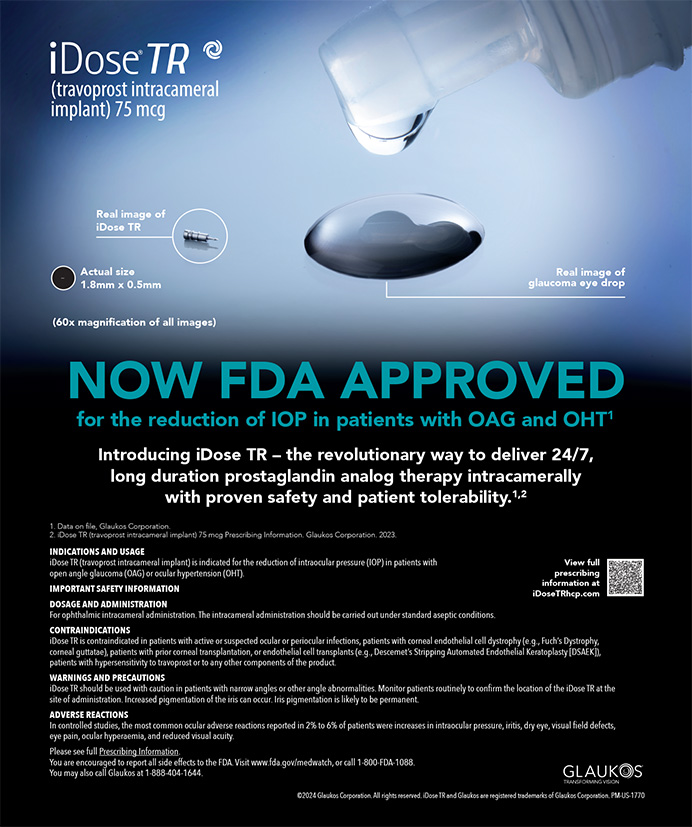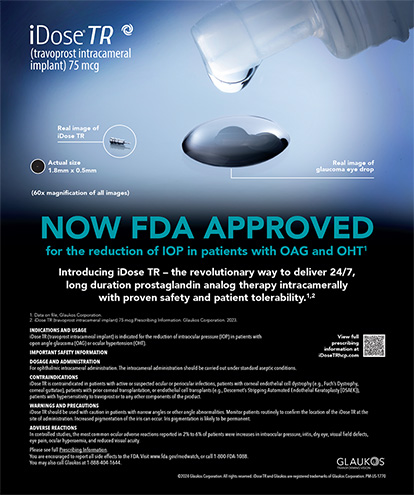In the aphakic state, the cornea alone determines the magnitude and axis of refractive astigmatism. In today's efforts to achieve pseudophakic emmetropia, it is critical to reduce higher magnitudes of natural corneal astigmatism.1 The alternative of correcting astigmatism with an IOL has distinct advantages compared with treatments directed at corneal tissue involving incisions2-16 or laser ablation.17-20 Implanting a toric IOL is a single-step, reliable, small-incision approach with a result that is independent of the postoperative corneal healing response. Toric IOLs can also correct higher degrees of cylinder than can corneal procedures.21-24
The Acrysof Toric IOL (Alcon Laboratories, Inc., Fort Worth, TX) has a single-piece design similar to that of the STAAR Toric IOL (STAAR Surgical Company, Monrovia, CA), but the former features compressible haptics made of acrylic rather than silicone. The Acrysof Toric IOL's recent approval by the FDA makes it worthwhile to review the results with the STAAR Toric IOL, the lens that has been the standard of care.
A HISTORICAL PERSPECTIVE
Investigations in the early 1990s used spherical (nontoric) IOLs to evaluate the rotational stability of various IOL designs.22,25,26 Three-piece lenses using polypropylene haptics showed significant counterclockwise rotation.22 Later studies demonstrated similarly frequent rotation within 2 weeks of implantation with loop- and plate-haptic designs but also showed that only the plate-haptic IOL was stable long term.27 The latter design also demonstrated significantly less decentration when compared to a three-piece lens.28
The first study of a toric IOL (STAAR 4203T; STAAR Surgical Company) in the US showed this plate-haptic design to undergo rotations of more than 30° in fewer than 5 of cases.29 Results from the phase 1 FDA trial showed that, in 95 of cases, the toric IOL was within 30° of the intended axis, with a mean achieved reduction in refractive cylinder of 1.25D.30
These early data indicated that, although rotations occasionally occurred in the early postoperative period, the plate-haptic design remained stable in the long term. The STAAR Toric IOL's AA4203-TF model (10.8-mm length) underwent a full FDA clinical trial that led to its approval in 1998. The longer (11.2-mm) AA4203-TL model was later created for use in larger myopic eyes.
THE STAAR TORIC IOL's DESIGN
The foldable STAAR Toric lens is a plate-haptic PCIOL (Figure 1) made of first-generation silicone and is implanted through a 3-mm incision. The TF model is available in spherical equivalent powers of 21.50 to 28.50D versus 9.50 to 23.50D for the TL model. The TL model's lower power range increases its stability against off-axis rotation in the large capsules of myopic eyes. Both versions of the lens have two 1.5-mm fenestration holes in the haptics to encourage capsular fibrosis, which promotes long-term rotational stability of the IOL and prevents its posterior displacement after an Nd:YAG capsulotomy.
Manufactured as a plus-cylinder lens, the STAAR Toric IOL features two hash marks at the peripheral optic junction that designate the axis of the toric power and should be aligned along the steep keratometric axis. The anterior-posterior orientation of this lens is important. It is packaged with the toric power facing upward, and the manufacturer's labeling calls for the anterior, toric surface to be implanted facing the anterior capsule. Alternatively, the STAAR Toric IOL may be implanted in a reverse configuration to promote rotational stability.31,32
MODERN-DAY CLINICAL RESULTS
The TF and TL models both predictably improve UCVA, although the incidence of early off-axis rotation with them varies.30-39 In sum, the studies show that the STAAR Toric IOL is more effective than limbal relaxing incisions (LRIs)33,34 and that it is reliable in reducing postoperative refractive astigmatism, is consistent in producing a UCVA of 20/40 or better, has a low incidence of early positional problems, and shows long-term stability.34-38 The longer TL model is more stable than the TF model.39 Other clinical studies have used the STAAR Toric IOL to correct excessive astigmatism by combining the lens with LRIs or using multiple STAAR Toric IOLs in a piggyback fashion.40-42
As a group, these studies clearly demonstrate that the STAAR Toric IOL produces a predictable and beneficial clinical reduction in preoperative refractive cylinder but also that it has a tendency toward occasional, early, off-axis rotation, the incidence and severity of which vary. The differences in these studies are likely due to many factors, including (1) the availability of only the shorter TF model in early studies, (2) variability between surgeons in their removal of viscoelastic posterior to the IOL, (3) torsional rotations that may occur when the patient is recumbent versus upright or due to unintentional misalignments, (4) implantation on the improper axis, (5) large capsules due to myopia, old age, or mature, brunescent cataracts, or (6) rubbing of the eye by the patient during the early postoperative period.
Recent advances have decreased the frequency of early misalignment with the STAAR Toric IOL. Foremost is the availability of the longer TL model for use in myopic eyes.39 Another is the reversed positioning in which the optic's toric surface faces the posterior rather than the anterior capsule.31,32 This implantation technique improves UCVA and increases the refractive effect, despite a theoretical 8 reduction of toric power that occurs when the toric surface resides closer to the nodal point. The more precise rotational alignment was more important than the mild theoretical reduction of toric power. The IOL's reverse positioning is now recommended and widely practiced in the US.
Fortunately, the infrequent misalignments can be fully corrected. Because these rotations occur in the early postoperative period, before capsular fibrosis or contraction has begun, repositioning the implant will restore its beneficial effect. Other IOL designs that rotate months after capsular fibrosis and contraction are very difficult to reposition. The optimal time for repositioning the STAAR Toric IOL is 2 weeks postoperatively. If manipulated earlier, the problem may recur. In contrast, later repositioning is difficult due to capsular fibrosis.
PERIOPERATIVE MANAGEMENT
Surgeons may use IOL formulae and nomograms as for any other IOL to determine which spherical equivalent power of the STAAR Toric lens to implant. They should then choose the 2.00 or 3.50D version depending on the degree of keratometric cylinder. The manufacturer states that the 2.00D IOL should be used in eyes with 1.40 to 2.30D of corneal astigmatism and that the 3.50 lens is indicated for corneal astigmatism greater than 2.30D. In my experience, it is best to choose the toric power based on the modified, "reverse" nomogram. For keratometric asymmetry of 1.20 to 2.10D, I use the 2.00D toric power in the reverse position. For corneal astigmatism above 2.20D, I use the 3.50D IOL in the reverse position. Eyes with less than 1.20D of corneal cylinder should not receive the STAAR Toric IOL, because a flip in the refractive astigmatic axis may result.
Like any plus-cylinder lens, the STAAR Toric IOL should be oriented to neutralize the keratometric astigmatism. The surgeon determines the intended axis of implantation preoperatively based on keratometric data. Topography and other imaging can help verify that the astigmatism is regular (irregular corneal astigmatism will not be appropriately corrected by the STAAR Toric IOL) and determine the steep corneal axis. Alternatively, the intended axis for implantation may be identified intraoperatively by qualitative keratometry.
As with all plate-haptic IOLs, the STAAR Toric lens should only be implanted with an intact capsule and a complete, continuous curvilinear capsulorhexis. Using the current cartridge, surgeons may deliver the IOL through a 3-mm clear corneal incision. The cartridge's tip does not need to enter entirely into the anterior chamber, but it does need to pass fully through the corneal incision. Surgeons must retract the plunger several times as the IOL is pushed down the cartridge to ensure no overriding of the plunger that could tear the trailing haptic. The leading haptic is inserted into a capsule filled with viscoelastic, and the trailing haptic is placed with a second instrument, as with other plate-haptic IOLs (Figure 2).
Surgeons may use the I/A tip, cystotome, or another second instrument to orient the IOL to the desired axis. The careful removal of viscoelastic from between the posterior capsule and the lens is important to help avert the early rotation of the IOL. This step occurs prior to the lens' final orientation along the desired axis. Some surgeons prefer to leave the eye slightly soft to encourage early contact between the capsule and the lens.
Although some eyes may require an Nd:YAG capsulotomy for posterior capsular opacification, there have been no reports of subsequent off-axis deviation of the IOL.
CONCLUSION
Although many cataract and refractive surgeons have gladly relied on the STAAR Toric IOL, others have avoided the technology for reasons such as its construction from first-generation silicone, its plate-haptic design, concerns about early off-axis rotations, and significant economic benefits from LRIs. With the availability of the Acrysof Toric IOL, US surgeons have a choice of toric IOLs for the first time. As our experience accumulates with the new lens, we may evaluate any improvements it offers in light of the extensive data and experience with the STAAR Toric IOL. Particular areas meriting comparison include ease of implantation, the frequency of early and late off-axis deviations, the facility of correcting such problems if they do occur, and long-term refractive stability.
Stephen Bylsma, MD, is Assistant Clinical Instructor for the Department of Ophthalmology at the University of California, Los Angeles, and is in private practice in Santa Maria, California. He is a consultant to STAAR Surgical Company. Dr. Bylsma may be reached at (805) 925-2637; sigste@aol.com.


